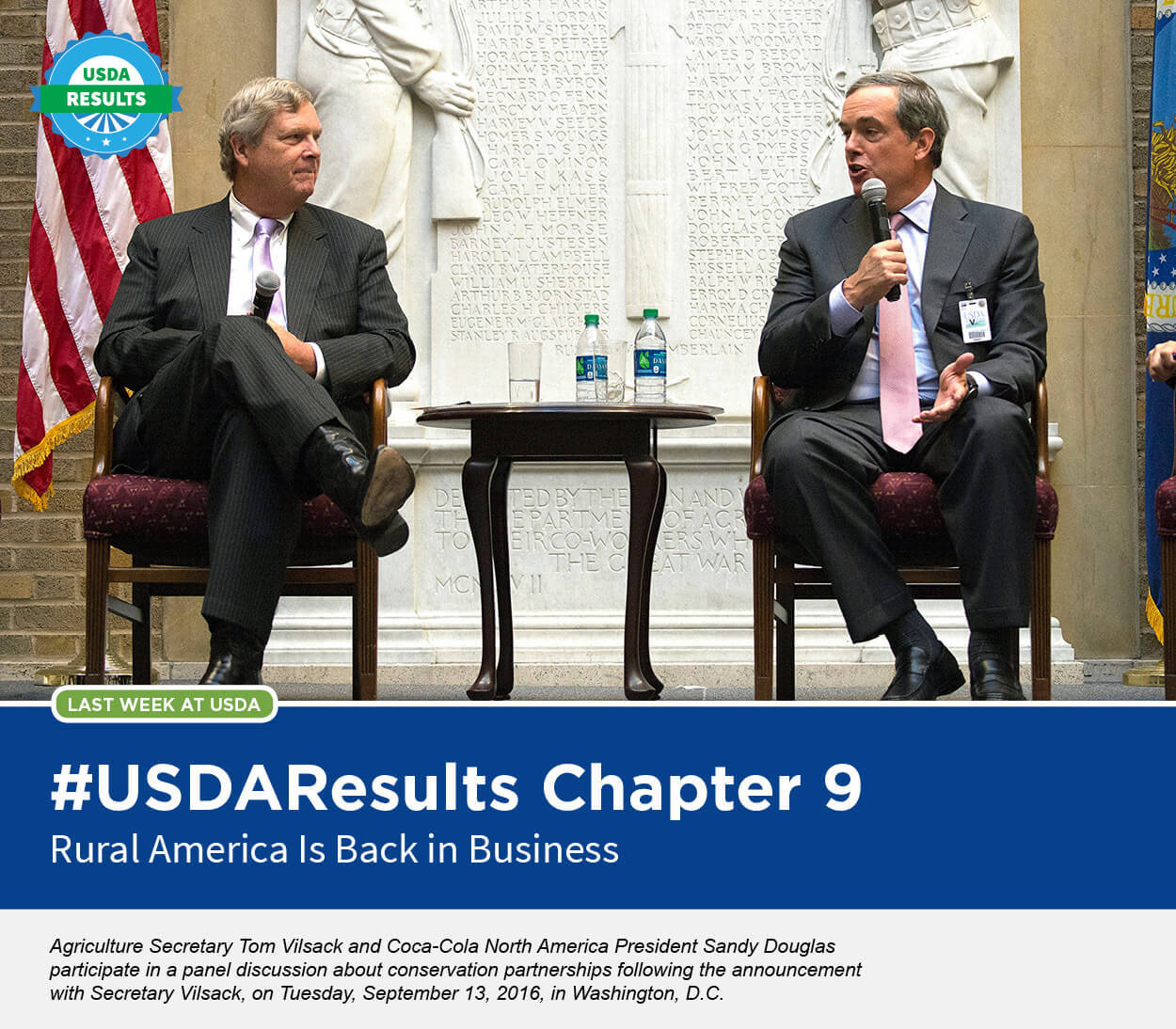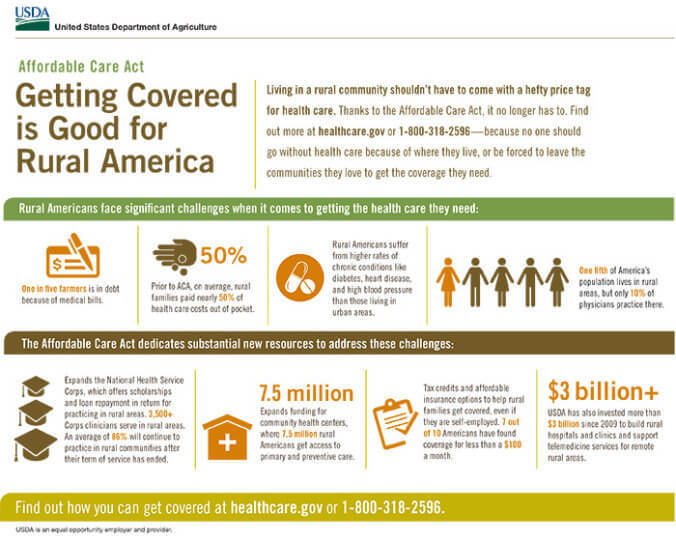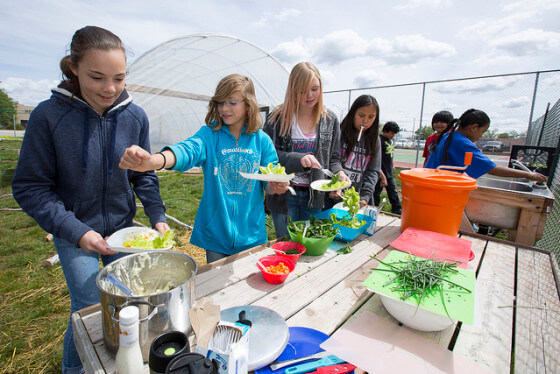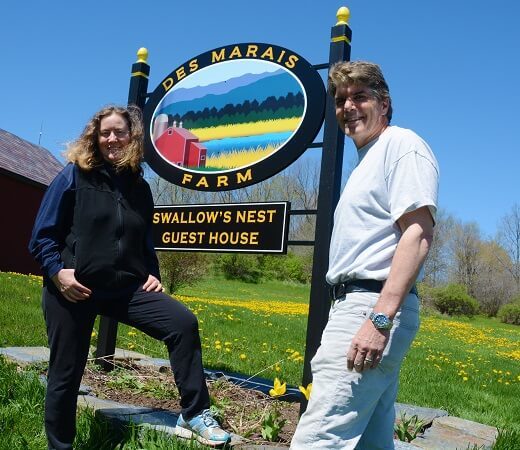



At USDA, we know that the potential of rural America is limitless. And with that in mind, since 2009, targeted strategic investments have helped a sustainable rural economy grow.
As part of USDA’s commitment to a robust 21st century rural economy that works to complement the production of food, fiber and fuel, last week, we announced that our partnership with Coca-Cola North America to restore and protect damaged watersheds on national forests achieved a milestone of one billion liters of water restored. We also announced a commitment to double that outcome through 2018. America’s 193 million acres of public forests and grasslands support approximately 200,000 full and part time jobs and contribute over $13 billion to local communities each year. The 13 restoration areas are located on national forest land, which provides drinking water to more than 60 million Americans. They help to ensure future generations of Americans will have access to fresh water.
Strong infrastructure is also critical to keeping America's communities of all sizes thriving. Last week, we announced an investment in 168 projects to improve water and waste infrastructure across the country. We also announced that we’re seeking applications for nearly $4.4 million in grant funding to help towns in the Delta region access high-quality medical and health care services, helping the area to support strong communities for generations to come.
Join us throughout the month of September as we tell the important story of eight years of significant and transformative investments across the nation that have empowered rural America to continue leading the way, strengthening America’s economy, as well as the small towns and rural communities that so many call home. Follow along on usda.gov, on the USDA blog and by using #USDAResults, or catch up on Chapter IX on our Medium site.



Throughout the month you can join us as we tell the important story of how eight years of significant and transformative investments across the nation have empowered rural America to continue leading the way, strengthening America’s economy, as well as the small towns and rural communities that so many call home.

1B litres → How much H20 we’ve restored on @ForestService land with @CocaCola http://ow.ly/Edrb304aDZ8

From the west coast to New England, rural communities across the country are implementing community food systems’ strategies. The projects are bringing more local food into school meals, promoting healthy eating habits and expanding markets for American farmers and producers.

Lyn and Jim Des Marais of Brandon, Vermont, are committed to protecting the wetlands on their 1,250 acre farm in the Otter Creek watershed.

Think Nutrition as High School Students Return to School
The start of the school year is a great time to get high school students thinking about the nutrition and physical activity choices they make. USDA’s Center for Nutrition Policy and Promotion (CNPP) and Team Nutrition have a variety of resources available to support high school educators as they guide students on their path to good health.
USDA Borlaug Fellow Helps Farmers in His Native Country
Issah Sugri of Ghana is helping his nation feed itself and improve its farmers’ efficiency thanks to a U.S. Department of Agriculture (USDA) program. The Norman E. Borlaug International Agricultural Science and Technology Fellowship Program, funded by USDA’s Foreign Agricultural Service (FAS), is a six to 12 week training program that pairs up-and-coming researchers from selected countries with mentors from a U.S. land-grant institution or government agency.
September is National Food Safety Education Month
Can you believe that September is already here? It may not feel like fall where you are, but, slowly, our focus has begun to shift from summer fun to returning to school and learning.
Good Land Management Helps Clean Waterways, Wildlife Rebound
You’ve seen those markers on storm drains that say: “No dumping. Drains to river.” Or to a “lake” or “creek.” It’s a reminder that what we do on the land has a direct impact on a body of water somewhere.
Working with Livestock Industry to Provide Critical Market Intelligence
The Livestock Mandatory Price Reporting (LMR) Program was created to expand pricing information available to the livestock industry. The data is collected and distributed by USDA’s Agricultural Marketing Service (AMS) through its USDA Market News division to provide market information for cattle, swine, lamb, and livestock products.
Don’t be a Zombie – Prepare for Emergencies
Nearly 60,000 visitors to this year’s Indiana State Fair encountered zombies lurking around in the corners. Actually, they saw cartoon zombies that were part of an interactive exhibit, Don’t Be a Zombie – Be Prepared. The exhibit consists of a walk-though maze and interactive video game designed to simulate a zombie apocalypse.
Digital Connection Helps Kodiak Students
For students heading back to school this month in Kodiak, it’s anything but “class as usual.” Because at Kodiak Island Borough School District, 400 miles from Anchorage and accessible only by airplane and ferry, ConnectED investments in high-speed internet and new technology have transformed the student experience — with remarkable results.
Knowledge and Passion: A Student Intern’s Perspective
I’m not sure that there are many 1890 National Scholar interns who are “ambassadors” of their university and who are planning a career in farming. But then, I never considered myself an average student. My experience during my undergraduate years perhaps is not typical. Not only was I a USDA 1890 National Scholar, but I also served as the “queen” of my university all while maintaining a 3.5 cumulative grade point average.
Local Foods in Schools Bring Rural Communities Together
From the west coast to New England, rural communities across the country are implementing community food systems’ strategies. The projects are bringing more local food into school meals, promoting healthy eating habits and expanding markets for American farmers and producers.
USDA Graded Cage-Free Eggs: All They’re Cracked Up To Be
When it comes to purchasing eggs, consumers have interests that go well beyond what they see in the carton. For many buyers, where that egg came from and how it was produced are just as important as the finished product. Organic, locally produced, cage-free, and free range are just a few of the marketing claims consumers will find on the carton, as producers try to communicate the attributes of their product.
The Year of the Flood
Incidents described as “thousand year storms and floods” and “the worst U.S. disaster since Hurricane Sandy” claimed the lives of more than 58 people in Louisiana, West Virginia and South Carolina over the last year. These disasters often remind us of the devastating impacts that families and their communities face after they strike.
Restored Wetlands Provide Critical Habitat for Migratory Birds, Many Other Species
Wetlands and wildlife – they’re made for each other. Wetlands provide critical habitat, shelter food and places to raise young.
Kenyan Credits McGovern-Dole Program for Changing His Life
As a young boy in eastern Kenya, Peter Mumo faced a life of poverty, hunger and illness. That is until he started receiving school meals at the age of nine through the USDA McGovern–Dole International Food for Education and Child Nutrition Program. After that, his life turned around. He started to gain weight, his health improved and he began doing well in school.

A Big Summit on Open Agricultural and Nutritional Data
People from around the world are gathering now in New York City for summit meeting on making agricultural and nutritional data more accessible and more useful. (Gary Crawford and Dr. Catherine Woteki)
Actuality: One Way Open Ag. Data Could Improve World Food Security
Dr. Catherine Woteki, Under Secretary of Agriculture, talking about one way that making more agricultural research data available and useful could help mitigate against climate change and avert a future world food crisis
The Importance Of Asia In Ag Trade
With a growing middle class, Asian markets represent a major opportunity for US ag exports in the future. (Rod Bain and USDA Deputy Under Secretary Alexis Taylor)
Mentoring New Women Ag Leaders In Two Nations
One piece of common ground for US and Chinese agriculture is the emphasis on mentoring a new generation of women as leaders in agriculture. (Rod Bain and Deputy Under Secretary Alexis Taylor)
US Ag Trade With China And WTO Challenge
A USDA official believes ag export opportunities in China will continue to grow, even with a recent challenge before the World Trade Organization. (Rod Bain and Deputy Under Secretary Alexis Taylor)
U.S. Files WTO Case Against China's Rice, Wheat and Corn Supports
The U.S. has launched a new trade enforcement action against China for excessive supports for rice, wheat and corn. (Gary Crawford, Amb. Michael Froman, Sec'y Tom Vilsack, Senator's Pat Roberts, Debbie Stabenow and Heidi Heitkamp. Congressmen Kevin Brady, Mike Conaway and Collin Peterson)
A Refreshing Partnership Reaches Goal Ahead Of Schedule
Partners from government, business and private organizations have come together to replenish one billion liters of water five years ahead of schedule. (Rod Bain. Agriculture Secretary Tom Vilsack. Coca-Cola President Sandy Douglas.)

Actually, Income in Rural America Is Growing, Too (The New York Times)
On Tuesday, when the Census Bureau released one of the country’s most important reports on income and poverty, dozens and dozens of facts were revealed. We found out that real middle-class incomes in America grew a phenomenal 5.2 percent, and that the poverty rate fell by the largest percentage in nearly 50 years.
CORRECTION: In Another Census Report, Rural Incomes, Poverty Improved (The Daily Yonder)
A Census report that said rural incomes had fallen and poverty had increased from 2014 to 2015 made an erroneous comparison. In fact, another report shows that income and poverty rates improved in nonmetropolitan counties during the period.
Urban and rural households enjoyed similar income gains in 2015 (Corrected) (Vox)
This article originally reported that urban households had seen their median incomes rise in 2015, while incomes in rural areas fell. But that appears to have reflected a statistical anomaly in the Current Population Survey. More reliable data released later in the week by the American Community Survey — another program of the Census Bureau — found that median household income in rural areas gained 3.4 percent, while urban and suburban households gained 3.6 percent. The text below has been corrected.
Federal food stamp program to test online shopping for recipients (Chicago Tribune)
… Times, they are a'changin', though faster for some than others. Online shopping has dramatically altered buying habits for most Americans in recent years, and now, the $75 billion federal food stamps program, officially known as the Supplemental Nutrition Assistance Program, or SNAP, is moving toward making that option available to the 43 million or so people across the country receiving benefits.
US complains of unfair government aid for Chinese farmers (Seattle Times/AP)
The Obama administration lodged a complaint Tuesday against China at the World Trade Organization alleging excessive government support for rice, wheat and corn that drives up production and makes it harder for American farmers to export the same crops to China.
U.S. Announces Trade Case against China over Agriculture Products (Wall Street Journal/AP)
The Obama administration on Tuesday challenged China over its support for domestic wheat, rice and corn growers, alleging that Beijing is subsidizing these industries in excess of internationally agreed levels. Beijing spent nearly $100 billion more than allowed under the World Trade Organization on “market price support” for those agricultural products in 2015, U.S. officials said in announcing a new case against China at the WTO.
US files trade complaint over China's 'excessive' Ag subsidies (CNBC)
The U.S. on Tuesday accused China of having unfair agricultural subsidies for three key crops, adding to growing tensions between the two nations. The complaint comes in a U.S. presidential election year when there's been China bashing by some candidates, including Republican presidential contender Donald Trump.
Agriculture Secretary Tom Vilsack proposes more help for migrant farmers (Arizona Republic)
The U.S. Department of Agriculture may soon help local farmworkers, many of them immigrants, get better access to fresh food and homeownership. USDA Secretary Tom Vilsack and Cesar Chavez Foundation President Paul Chavez met Wednesday to begin a partnership that could bring community gardens to foundation-owned housing complexes, provide after-school nutrition programs or help some families who are renting homes become homeowners.
Coke is it: USDA touts water-savings program with soda giant (Greenwire)
A joint effort by the Department of Agriculture and Coca-Cola North America to conserve water in national forests has restored 1 billion liters of water, Agriculture Secretary Tom Vilsack said today. Vilsack and Coca-Cola North America President Sandy Douglas said they would commit to doubling those results through 2018.
Digital connection helps Kodiak students (Alaska Dispatch News)
For students heading back to school this month in Kodiak, it's anything but "class as usual." Because at Kodiak Island Borough School District, 400 miles from Anchorage and accessible only by airplane and ferry, ConnectED investments in high-speed internet and new technology have transformed the student experience — with remarkable results.
Vilsack Floats Idea of ‘Food Council’ for Next Administration (Bloomberg BNA)
… But something it doesn’t have is a council to help stakeholders navigate the dozen-plus agencies tasked with regulating agriculture and food safety. That’s a challenge the next administration should take up, Agriculture Secretary Tom Vilsack said last week during an advisory committee meeting on agriculture biotechnology.
USDA Secretary Touts Bio-Based Goods, Conservation (GW Today)
“The federal government buys a lot of stuff,” U.S. Secretary of Agriculture Tom Vilsack told a capacity crowd last Thursday, as the keynote speaker at George Washington University’s daylong GreenGov Symposium that was held in partnership with the White House Council on Environmental Quality. Secretary Vilsack, the longest-serving cabinet member who was sworn in the same day as President Obama, was promoting the administration’s policy on sustainability as a means of preserving natural resources for future generations, protecting the environment and mitigating the effects of climate change.
Rural America's New Cash Crop: Renewable Energy (Take Part)
A winery with a solar array in rural Oregon. A greenhouse in Montana tapping geothermal energy. A farm in Kansas that deployed an energy-efficient irrigation system. These are just a few of the more than 15,000 small businesses and family farms around the country that have received a clean-energy boost from an unexpected source: the United States Department of Agriculture.
Protecting Iowa's access to international markets (The Gazette)
Exports are vital to U.S. economy as a whole, and are especially important to American agriculture. Over the past seven years, U.S. farmers and ranchers have exported $1 trillion in food and agricultural goods to countries around the world. Those exports account for 20 percent of total farm income and support more than 1 million American jobs.
USDA takes a step toward letting people use food stamps online (CNN Money/ABC)
On Thursday, the Department of Agriculture put out a call to action, asking companies to apply for an upcoming pilot program that would enable people to use food stamps for online grocery purchases. Approximately 45 million people used the Supplemental Nutritional Assistant Program (known as SNAP) in 2015. And yet there's currently no way to cash in on those benefits online. This pilot program is the first step.
Federal food stamp program to test online shopping for recipients (Chicago Tribune)
Starting next summer, Illinois residents on food stamps may be able to buy their groceries online through a two-year federal pilot program intended to increase food access for the poor. Times, they are a'changin', though faster for some than others. Online shopping has dramatically altered buying habits for most Americans in recent years, and now, the $75 billion federal food stamps program, officially known as the Supplemental Nutrition Assistance Program, or SNAP, is moving toward making that option available to the 43 million or so people across the country receiving benefits.
Soon, people will be able to use their food stamps online in new pilot program (Mic)
People can't use food stamps on the Internet, but that's about to change. The U.S. Department of Agriculture announced Thursday that it is accepting applications for food retailers to participate in a pilot program allowing people to purchase groceries online using food stamps. It will select up to five retailers that will sell food to people in three states. The three states in question will be announced in December, a USDA spokesperson said in an email.
Vilsack: Universities vital to helping farmers survive climate change (Arizona State University)
Food security is vital to America’s freedom, and protecting farmers from the effects of climate change will require the collaboration of universities, the U.S. secretary of agriculture said. Tom Vilsack, who has been the nation’s Ag chief for the entirety of the Obama administration, spoke at Arizona State University on Wednesday about the impact of climate change on farming and ranching. The Fall Forum event was sponsored by the Julie Ann Wrigley Global Institute of Sustainability at ASU.


|

